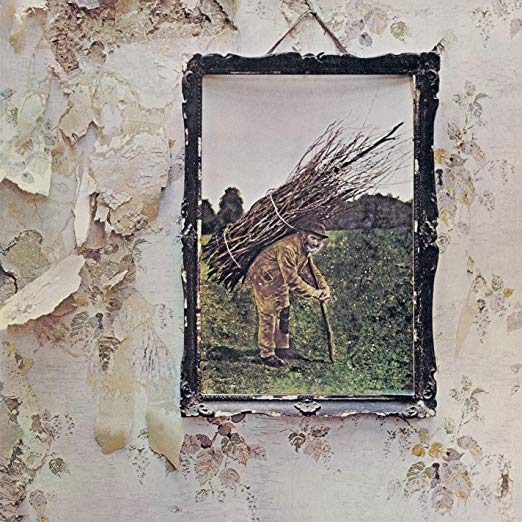There’s a series on Amazon called “classic albums” that are one-hour documentaries about the making of some of the most iconic albums of the classic rock era. I caught one by accident one afternoon about Deep Purple’s “Machine Head” album. It was quite good with all the band members providing their recollections of their time in Switzerland in December 1971 recording this record.
There are some really cool albums in this series[1]and I’ve been meaning to watch more of them. Last week I watched the show on the making of Led Zeppelin’s fourth album. The album was recorded in December 1970 at Headley Grange, an estate size home in the English countryside. According to the documentary the band completed the principal recording in six days, which is pretty amazing considering the material. Now completing the overdubs and mixing took much longer (guitarist Jimmy Page mixed the album twice) and the album wasn’t released until November 1971.
The other thing that delayed the release was the album cover. The band, somewhat in reaction to the press critics of the band, and there were many, decided to release the album without a title. Not only that but the Led Zeppelin name would also not appear on the cover or the album itself.[2] . The only identifying marks provided, inside the gatefold and on the album label, were four symbols (one for each member of the band).[3] Their record company thought this was completely nuts (“professional suicide” was their manager’s reaction). But Led Zeppelin was at the peak of their powers and had the weight to defy the record company. They had faith that their fans would figure it out. [4]

Fans and critics immediately began calling the album Led Zeppelin IV (or SOZO the symbol attributed to Jimmy Page). Though this was the most extreme example there have been other instances where fans and critics have come up with a name for an album other than it’s official title (or lack of title in this case). Here are a couple of examples from my record collection:
The Beatles, “The Beatles”. This 1968 double album with its all white cover and the band’s name in raised white letters on the bottom left was almost quickly dubbed “The White Album”. Through the years others got in the game of color-coding their album names. Prince released his “Black Album”. Weezer has made a career of different color album covers.
Jackson Browne, “Jackson Browne”. The singer-songwriter’s first album cover featured his name and his silkscreened image imposed over a canvas wine sack. At the bottom of the wine sack image were the words “Saturate Before Using”. Everyone thought, incorrectly, that this was the name of album. This moniker became such a given when referring to the record that eventually it became the official name of the album with subsequent pressings listing the name on the spine of the CD.
In recent times, with the Internet and the advent of social media, more bands and artists have released records without a title and/or their names. In 1971 though this was a groundbreaking move from a band that broke a lot of ground during their time.
ARTS ROUNDUP
Books – “IQ” by Joe Ide. I bought this book by mistake while ordering something from Amazon on my phone. One day it just appeared on my Kindle. Call it a happy accident. The book’s featured character is Isaiah Quintabe (IQ) a highly intelligent, high school dropout from East Long Beach, California who takes on cases for people in his neighborhood (thefts, lost daughters…). In this first book of the series Isaiah, along with his sidekick Dodson, are hired by a successful L.A. rapper to figure out who is trying to kill him. The story flashes back to provide the backstory about how Isaiah came to his profession as “unofficial” private eye. Isaiah is part Sherlock Holmes part Travis McGee and the dialogue is crackling and feels authentic. I will be visiting with IQ again soon.
Music – Bob Mould, “Sunshine Rock”. If you like his post-Husker Du output, particularly the rocking stuff, this record is for you. Mould’s skill of crafting catchy melodies over his buzzing guitar has been a constant throughout his career. This is another offering of well-constructed, catchy tunes that you will want to hear again and again.
Podcast – Malcolm Gladwell, “Broken Record”. This is a new podcast from the author and columnist that features interviews with artists and others from the music industry. It’s an eclectic lineup of episodes and I chose the one with producer Rick Rubin. Gladwell discusses Rubin’s work with Tom Petty on the 1994 “Wildflowers” album. Gladwell is an enthusiastic and well-prepared interviewer and the Zen-like Rubin is well spoken and thoughtful. I’m looking forward to the next installment of this series later this year.
[1]Fleetwood Mac’s “Rumours”, Elton John’s “Goodbye Yellow Brick Road” and Tom Petty’s “Damn The Torpedoes” to name a few.
[2]The catalogue number was also omitted from the album cover spine.
[3]Foreshadowing Prince’s decision to become known only by a symbol for part of his career.
[4]Led Zeppelin went with the no title/no band name approach again with the cover of their next album “Houses of the Holy”. The record company this time was allowed to put a wrapper on the album with the title and band’s name. The CD release had the title and band’s name on it.